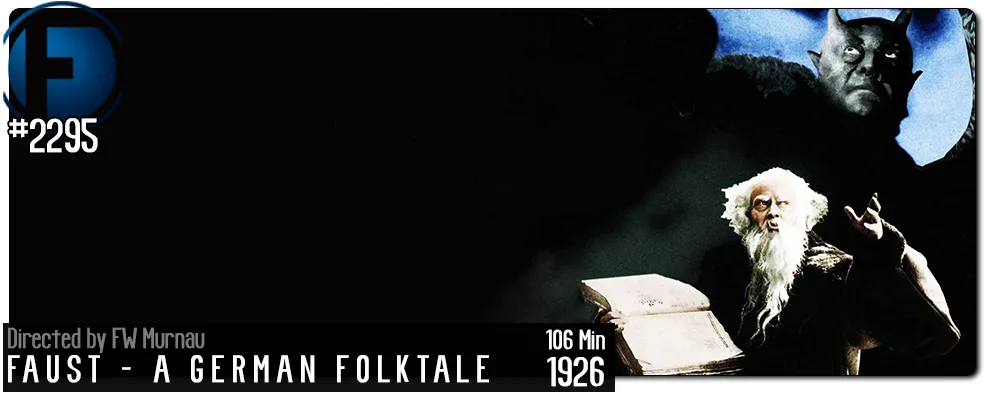Movie Review – Faust: A German Folktale (1926)
Principal Cast : Gösta Ekman, Emil Jannings, Camilla Horn, Frida Richard, William Dieterle, Yvette Guilbert, Eric Barclay, Hanna Ralph, Wener Fuetterer.
Synopsis: The demon Mephisto wagers with God that he can corrupt a mortal man’s soul.
********
This review is derived from viewing the US release version of Faust, running some 107 minutes.
Is Faust one of the greatest silent films I’ve ever seen? Well, no, but legendary German director FW Murnau’s silent expressionist masterpiece is arguably the greatest visual film to come from his pre-Hollywood career. Murnau was a successful filmmaker in his native Germany in the early 1920’s, carving out such memorable genre pieces as Nosferatu and Phantom before the one-two punch of Tartuffe (a comedy starring Emil Jannings) and Faust in 1926 – to suggest Murnau was pigeonholed into horror following Nosferatu is incorrect, for he seems to have tackled a number of different subgenres (including the less interesting Tabu: A Story of The South Seas) in his tragically all-too-brief career. As his final German film production prior to arriving in Hollywood and making the all-time-great masterpiece Sunrise: A Song of Two Humans, Faust represents (to me at least) Murnau at his most creatively unchained, a feast for the eyes laid out before us in what is perhaps the strongest visual triumph of the period I’ve seen to date. Faust is, in a word, spectacular, enough to engross even my young daughter and my usually disinterested wife in the tragic (sort-of-true) story of Johann Goethe’s play, which itself is based on the life of 15th Century alchemist Johann Georg Faust, a man who became popularised as having made a deal with the Devil (or a demon) to material gain. In Murnau’s film Faust is wanting to help his plague-ridden village, without success, and he makes a pact with the demon Mephisto to help them…. only to succumb to worldy pleasures.
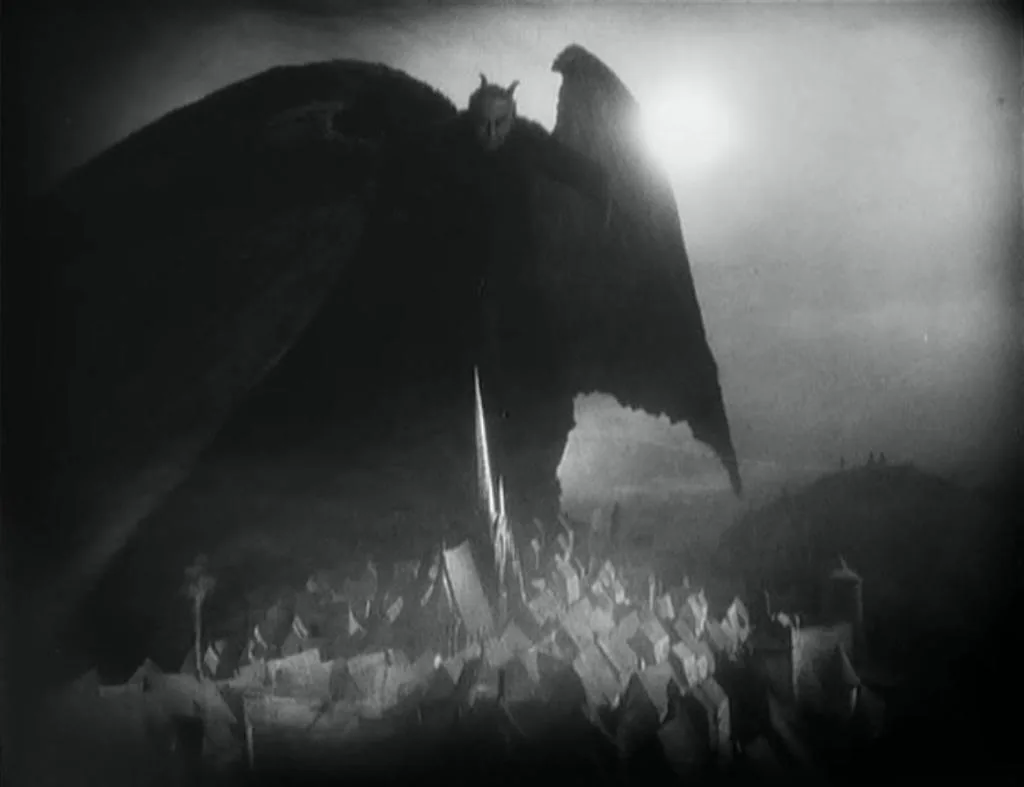
The story of Faust in Goethe’s 1808 play has to some degree created a legend out of mythology, some of which is rooted in truth and yet most of which is likely great fodder for a morality fable. Faust (played here by Gösta Ekman, a noted German stage actor, director and singer, who would also co-star alongside Ingrid Bergman in Intermezzo in 1936) has become the catchword for a person of typically good moral and ethical standing making poor decisions or bargains that go terribly wrong, usually with some level of selfish material gain as well. In this adaptation, Ekman’s Faust is an old man living in a village that is slowly succumbing to the ravages of the plague, perhaps an echo of the Black Death that tore through Europe between 1346 and 1353, and he is tortured by the fact that his potions and faith are not enough to prevent it. Desolate from the death and grief around him, Faust discovers that he can achieve power and glory by making a pact with the Devil, and so he arrives at a literal crossroads to summon a demon, Mephisto (aka Mephistopheles), played by Emil Jannings. After signing Mephisto’s pact in blood, Faust is granted powers to save his village, but the demon also tempts him with worldly pleasures and a return to the beauty of his youth. Eventually, Faust falls for the lovely, innocent Gretchen (Camilla Horn), but their affection is usurped by the duplicitous demon and their tragic fate is met with glee by many of the townsfolk.
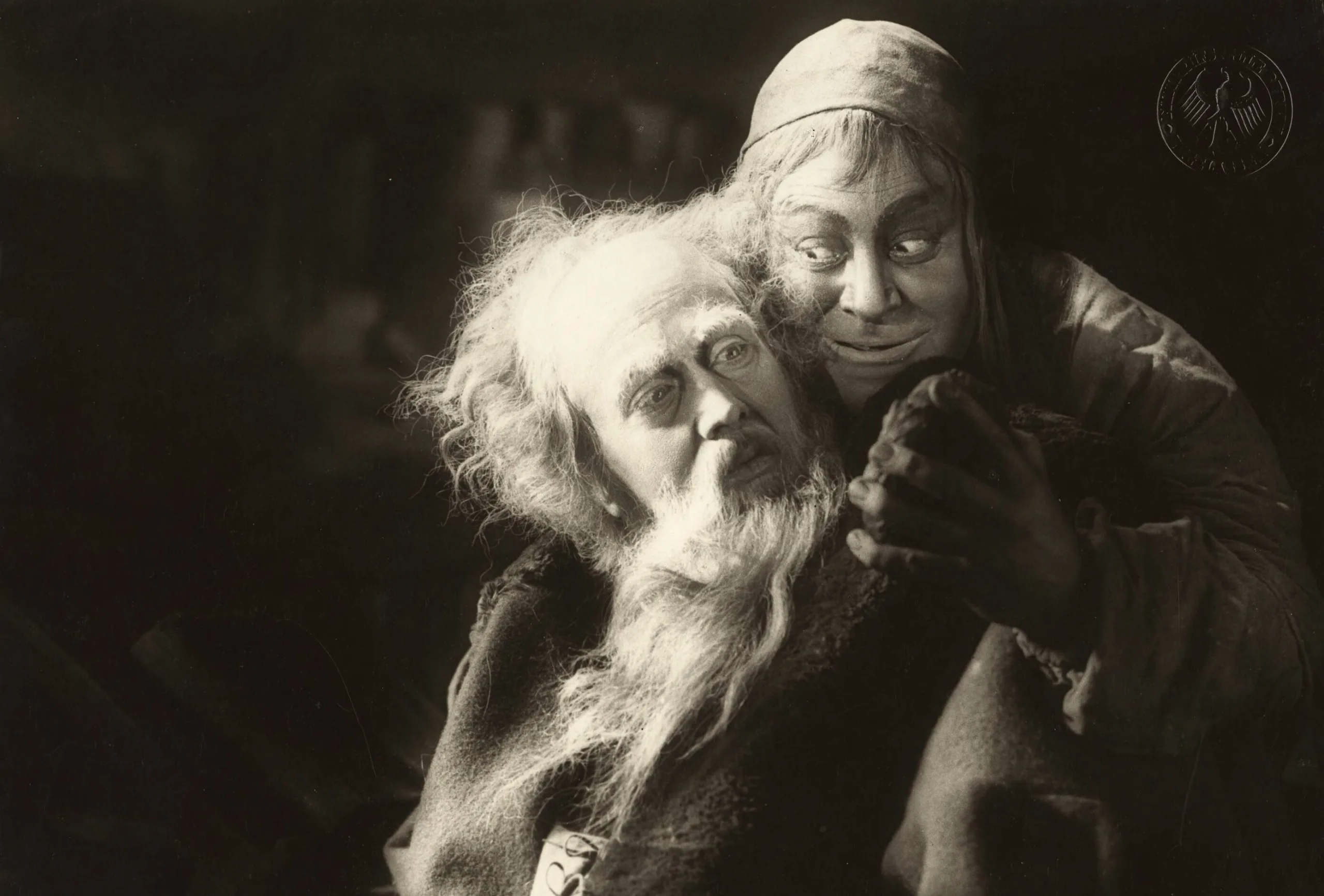
Faust is a triumph of visual symbolism, cinematographic inventiveness and visual effects bedazzlement. From the opening frames of skeletal demons riding ephemeral apocalyptic beasts through the heavens to the climactic moment the archangel smites down Mephisto’s pact with Faust, every frame of this film is startling for its narrative complexity, showcasing a sheer potency of vision and muscular directorial flourish that remains simply jaw-dropping nearly a century later. The opening act in particular is truly awe-inspiring, as the demon Mephisto towers over Faust’s home village, smoke and terror rolling into the cramped, crooked narrow streets. It’s as strong an opening sequence as there has ever been in the history of the medium. Shot entirely on studio lot over six months and becoming the most expensive German silent film of its day (that was, until Fritz Lang’s Metropolis dropped the following year), Murnau’s piercing visual style is evident in every frame. Although the plot leans heavily into both Christian and secular iconography as Faust literally battles his demon(s), and the central love plot between Young Faust and Gretchen sometimes becomes a touch saccharine, Murnau crafts a film of such deep thematic visuals and cerebral humanist questions it’s impossible not to be simply gobsmacked by the finished product irrespective of your faith status.
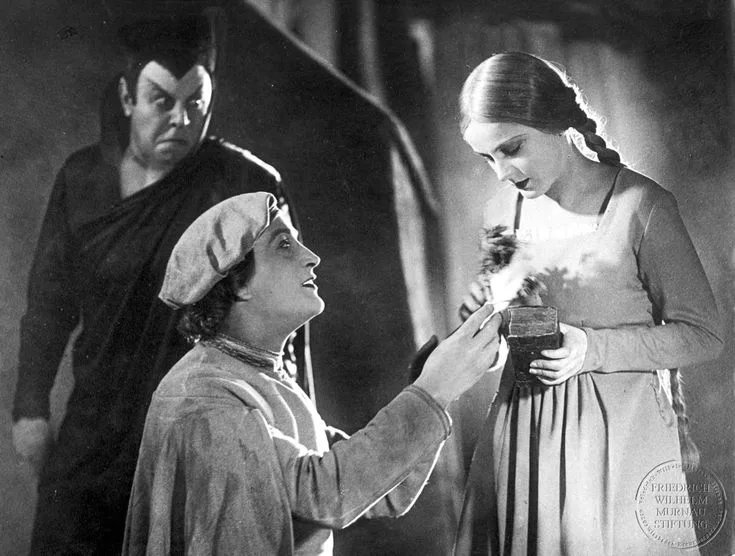
It should be noted that Faust is one of those rare films whereby a number of different versions were released in different markets; Murnau and producing studio Ufa produced at least five known versions of the film, many of which contained alternate cuts, actors in different costumes, alternative camera angles, and altogether different scenes – in one, a scene with a bear appears to actually attack an actor, although this was not included in the version released by Kino International (and currently available on restored BluRay, as well as a number of unrestored YouTube uploads) so navigating the history and legacy of Faust is fraught with intrigue. The current available version, however, is breath-taking, despite technical limitations of the mid-1920’s German film industry they were cranking out some absolute blockbuster material. Indeed, Faust is to Murnau’s career what Michael Bay’s Transformers franchise is today: the story and characters one can take or leave, but the visuals are worth the price of admission alone. Apologies to Murnau for comparisons to Michael Bay, but in the modern vernacular this is the stark difference between remarkable storytelling and masterpiece.

Every shot, every frame of this film moves the story along, and although some of the acting can be overly-theatrical in the traditional silent-film way, Murnau’s camerawork, lighting and production design is… well, it’s just amazing. Set design, from the constricted village streets and cramped, off-kilter houses in which the villagers live, to the shadowy oppressiveness of Faust’s home, to the loveliness of Gretchen’s little life and the eventual ruin of all, the film is big budget and handsomely mounted, to say nothing of Carl Hoffmann’s amazing cinematography. The layers of symbolism and sinister shadowy evil lurking in the corners and at the edges of each sequence is remarkably powerful, and the editing between interstitials – which themselves move the plot along quite quickly – is terrific. There’s a malignancy to Murnau’s take on this tragedy, underpinning and informing on every beat of plot and move of the camera – rare tracking shots are included here, something I don’t think Hollywood really took on until years later, and Murnau’s camera seems to move everywhere within the space the story demands. In terms of framing and design of what we see in the camera, Faust is astoundingly strong.
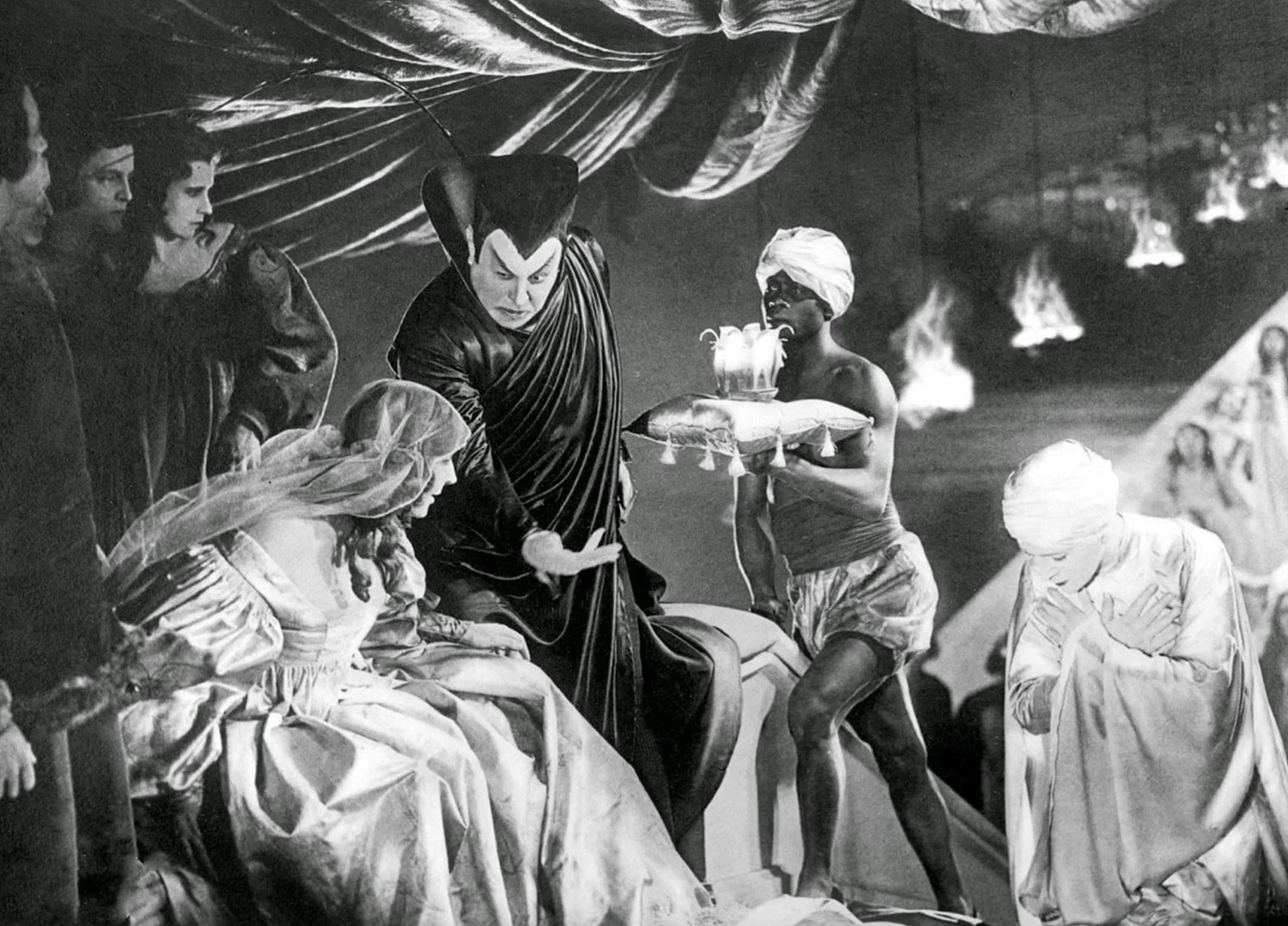
Equally as strong is the stunning use of practical in-camera visual effects. Although most of Faust would likely be shot on blue-screen and finished with cutting edge computer graphics if made today, in 1926 the technology available was highly restrictive by comparison. That doesn’t appear to have phased Murnau, for he delivers one of the most technically complex visual effects blockbusters I’ve seen in a silent film. He utilised every trick in the book, from double exposures, rear-projection, overlays, model work (the village and a lot of the “bird’s eye view” moments showcase the attention to detail, which look dated by today’s standards but are robust when considered in the context of the time) and fascinating editorial panache – at one point, Faust and Mephisto depart Faust’s apartment riding on the demon’s cloak as a kind of “magic carpet”, and the technique must have surely wowed audiences back in the day. Heck, it wowed me simply for how unexpected it was. The film is noted for a famous shot in which the pact Mephisto presents to Faust is revealed by flames on a piece of parchment that baffled me as to how it was executed – even now I re-watch it incredulously, wondering how 1920’s filmmakers managed to pull it off. Murnau’s style is easily a forerunner to modern contemporary Robert Zemeckis, pulling out trick shot after trick shot to dazzle the viewer with astounding filmmaking prowess.
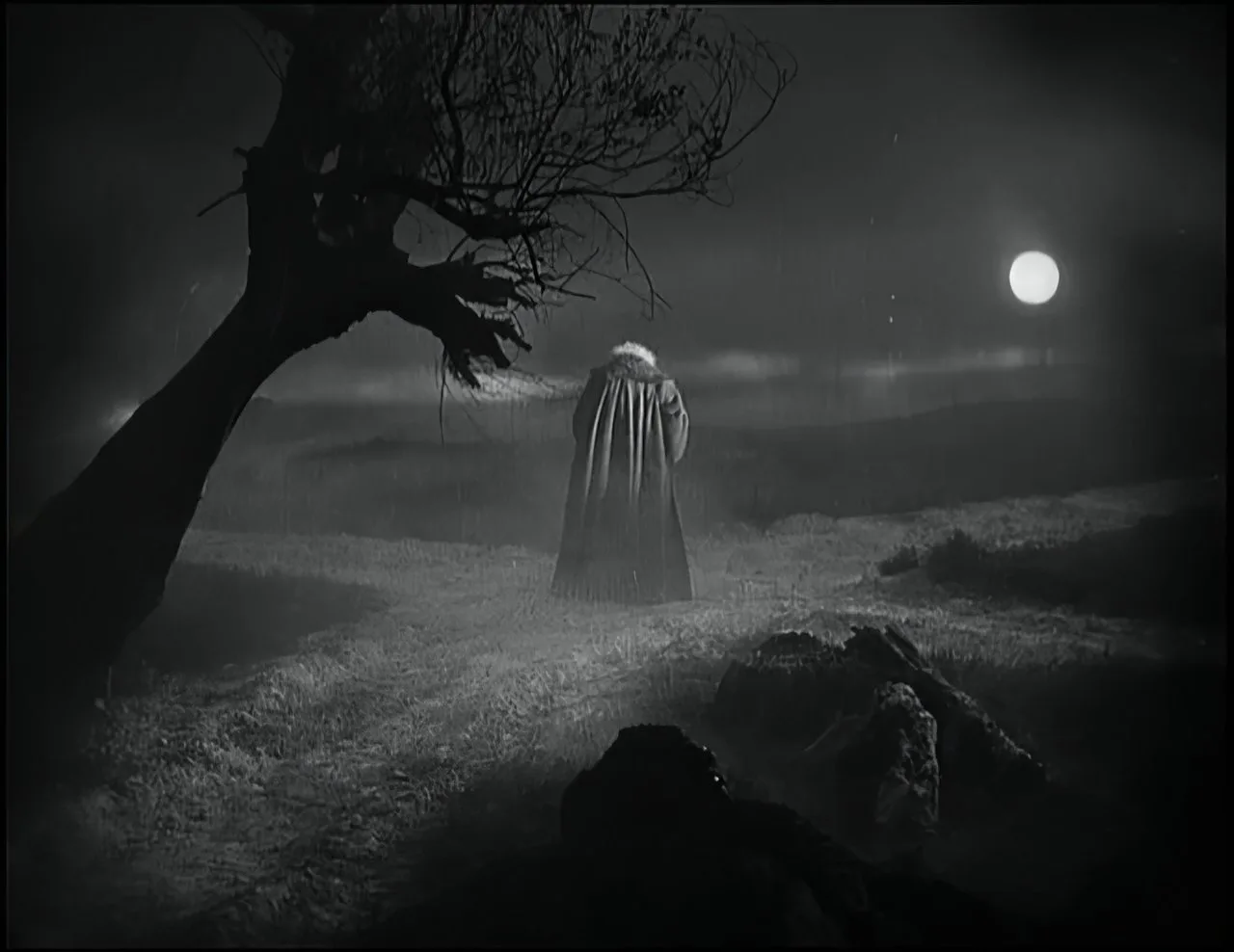
I do realise I’m sounding a touch hyperbolic stepping away from Faust after my first watch, but it really is a tremendously invigorating film. The story and characters are rooted in cultural myth, and honour the seriousness with which people take such analogous literature, while the visuals really do transport the viewer to another time and place with consummate ease. Sure, it’s a silent film made a hundred years ago, and as such you should expect hundred-year-old technology and performances, but if you recognise the skill and precision with which every frame of this thing is of the highest calibre of filmmaking, Faust is an astonishing piece of art. Heck, even if the story doesn’t float your boat, as a showcase of filmmaking genius (and I’ve said this before about FW Murnau!) this one is hard to top. Just remarkable; hugely recommended for any fans of film, silent or otherwise.

